Heirloom squash often taste better than hybrid varieties, which have been grown to look pretty or ship well. This guide will help you grow or cook with the best of them, distinguishing which are best for soup, desserts or baked pumpkin seeds. Like heirloom tomatoes, heirloom squash are distinctive in flavor, color and uses!
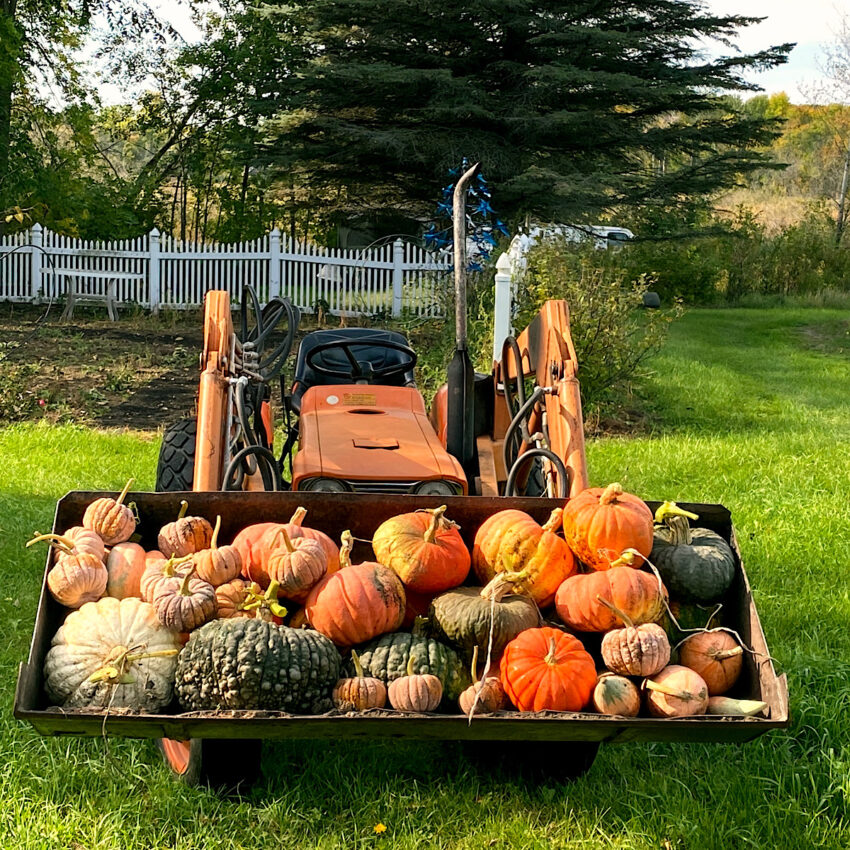
Jump to: How to Cure for Winter | Popular Varieties | Pumpkins vs Squash | Common Questions
This post may contain affiliate links. As an Amazon Associate, I also earn from qualifying purchases. You can read our disclosure information here–
How to ”Cure” Squash for Winter Storing
Got a great squash harvest this year and worried you’ll be eating pumpkin soup for a month straight? Don’t be! Squash store fantastically, and I’m not talking frozen either (although that’s also an option). As long as you cure them properly to harden the skins, they will stay delicious right in your pantry for months.
For the best results, pick your squashes when they’re fully ripe and colored up, but before the first frost can weaken them. Be sure to leave a few inches of stem on each one for extra protection. Then, just lay them out on your porch or another sunny spot that’s dry and gets good ventilation.
For 1-2 weeks, turn the squashes regularly. You’ll notice the relatively flimsy skins harden significantly during this time, giving your harvest all the extra protection from molds and bacteria that it needs.
Store the squashes in a cool (not cold) and dry place. You’ll be able to enjoy some of them all the way into Spring!
10 Popular Heirloom Squash Varieties
1. Blue Heirloom Squashes
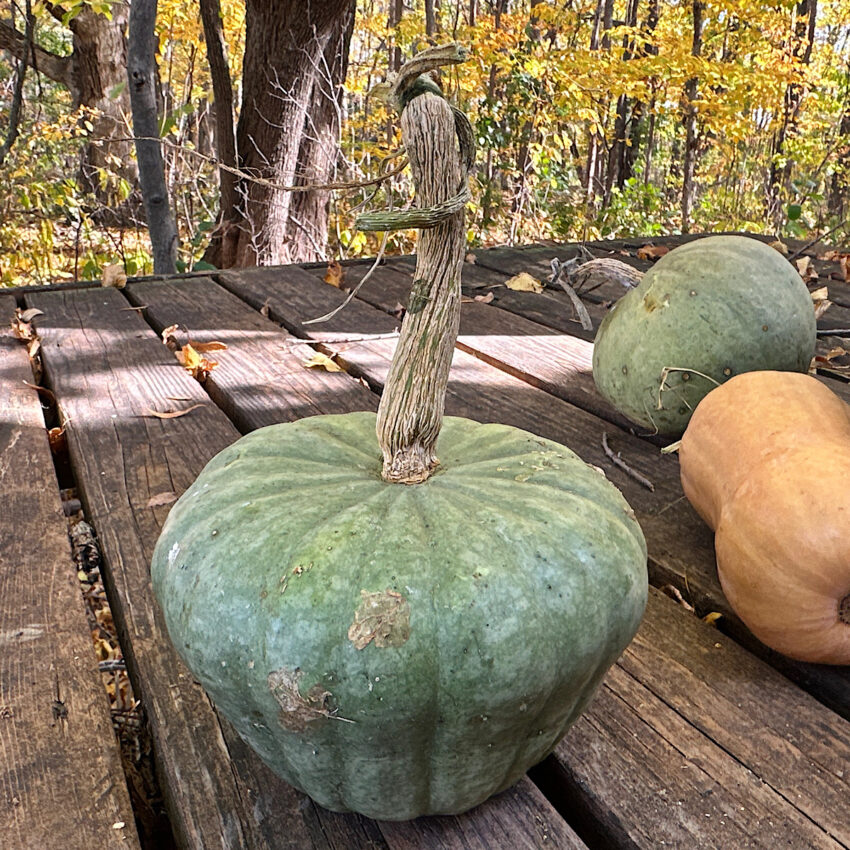
A blue squash refers to any type of squash or pumpkin that is a greyish blue in color. Quite nice to look at, and there are many different varieties to choose from in all sizes and flavors. I always grow at least one or two in my Fall garden.
Here are some well-known blue winter squashes to consider:
- Hubbard: A large heirloom with bumpy skin and beautifully orange, richly flavored insides. It has apparently been around since the 1830s. Needs up to 120 days to mature and is fantastic to roast whole or in cubes.
- Queensland Blue: Deeply ribbed and wider at the top than the bottom, this one looks a little like a greenish-blue cupcake. It’s Australian in origin and first popped up in the US in the 1930s. A great choice for this homemade pumpkin butter recipe.
- Sweet Meat: Another popular heirloom variety, Sweet Meat originates from the Northwestern US, specifically Oregon. It’s perfectly suited to its climate of origin and beyond, and yes, it is quite sweet in flavor! I think it’s a perfect contender for cold-weather soups.
- Marina Di Chioggia: As its exotic name suggests, this squash was developed in Italy. In fact, it’s been around since the 1600s, and is still a huge favorite today. Its warty, greyish-blue skin and bright orange flesh make it a real eye-catcher. Why not use it for an Italian pumpkin recipe, like this pumpkin gnocchi?
- Jarrahdale: This Australian native looks exactly like you’d expect a classic pumpkin to, with deep ribs and a slightly flattened top. The only difference is that it isn’t orange, but slate blue! This one matures in around 100 days and is fantastic for soups or roasting with root vegetables.
- Buen Gusto de Horno: Its name translates roughly to ‘good oven taste’, and I have to say this one is my all-time favorite in terms of taste. This ultra-warty Spanish heirloom pumpkin is oh-so-delicious when roasted. It’s a little less productive than other squashes and does need a relatively warm climate to thrive, but the novelty of it makes it more than worth it for me.

2. Cinderella Pumpkins
The proper name for this French heirloom variety is Rouge Vif D’Etampes (Bright Red from Etampes), but let’s just call it the Cinderella pumpkin here. After all, it really does look like the classic orange pumpkin that turns into a carriage to take Cinderella to the ball! It’s bright orange, ribbed and slightly flattened.

This attractive variety of Cucurbita maxima has been around since at least the early 1800s. It was originally developed and grown in the town of Etampes, close to Paris. It was brought to the United States by Burpee in the 1880s and has been commonly used for both Fall displays and cooking ever since.
The Cinderella pumpkin is a medium to large variety that can weigh up to 35 pounds. It generally matures in around 110 days, which is pretty average for a heirloom winter squash, and likes full sun. Its flesh is creamy and mild, with a slight sweet note.
Tip: I used some of my Rouge Vif D’Etampes pumpkin to make a Fall-flavored DIY shrub syrup to use in cocktails and other drinks. It also works fantastically for a this pumpkin bourbon Martini.
3. Long Island Cheese
Although Long Island Cheese doesn’t sport the aforementoned Cinderella pumpkin’s bright orange color, don’t let that trick you into thinking it’s inferior in flavor. It also doesn’t taste like cheese: the name is a reference to the fact that these squashes can look a bit like a wheel of cheese.
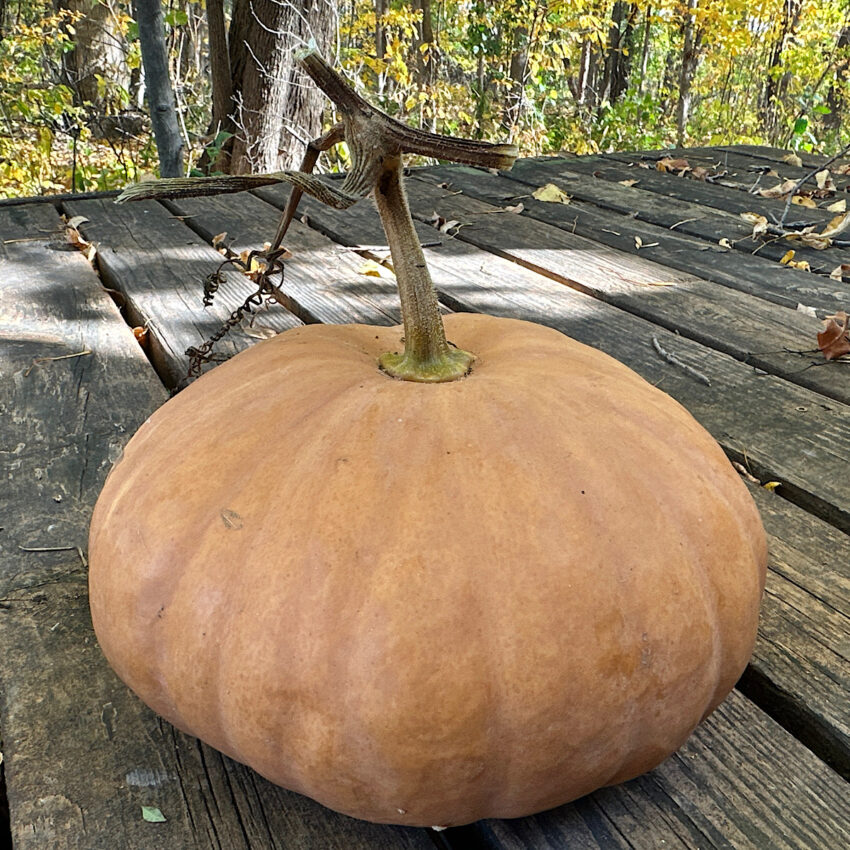
A properly grown Long Island Cheese contains wonderfully rich and mildly sweet flesh that’s appreciated for its lack of strings. First grown in New York from at least the early 1800s, it’s a cultivar of Cucurbita moschata.
Long Island Cheese variety was later commercialized as a great choice for classic pumpkin pie. I like it in this pumpkin cheesecake recipe,.
Long Island Cheese pumpkins will need around 100 days to mature, which is a little shorter than most other heirloom varieties. They like full sun, plenty of water and a lot of space to vine.
4. Pink Banana
The Pink Banana squash lends its name from its shape and color: it’s pale and elongated, sometimes even with a slight curve to it, and a pinkish orange in color.
This is a member of the banana squash subcategory of Cucurbita maxima, one of the four species of edible squashes. It has been in cultivation in South America for more than a thousand years.
This winter squash can grow very large, attaining sizes of up to 4ft. It’s not unusual to find Pink Bananas that weigh 45 pounds or more. You’ll have plenty of leftovers to make this pumpkin ancho soup recipe.
Another great thing about the Pink Banana squash is the fact that it’s quite easy to grow. Many growers note that it does well even in rainier and less sunny climates, conditions that aren’t appreciated by some other winter squash cultivars. The fruit will be a little smaller is this is the case, but that’s not a problem. If you let it get too big, it can become stringy anyway.
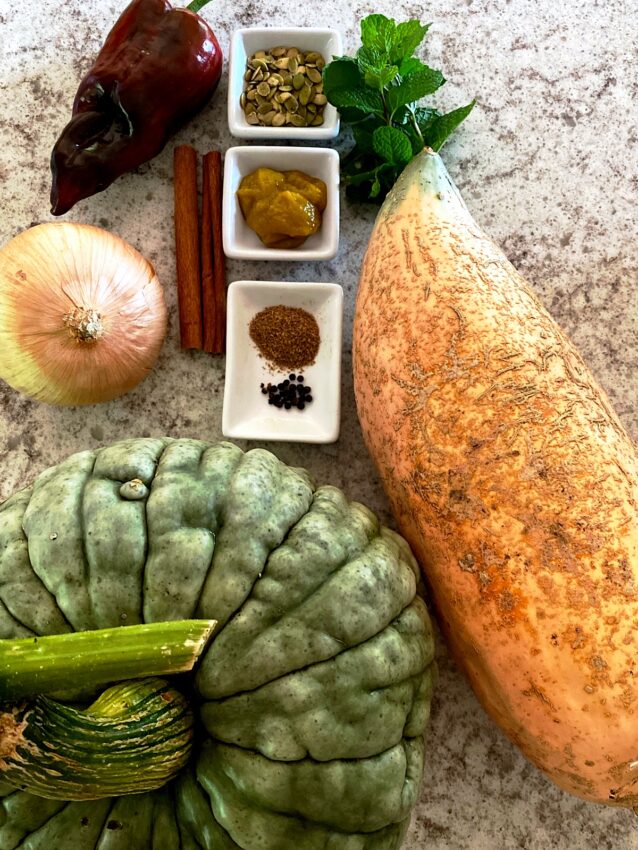
5. Butternut Squashes
One of the most well-known squashes is the elongated butternut squash. Sweet and slightly nutty, this one’s a Cucurbita moschata variety originally bred in the US in the 1930s. One of its main ancestors is the Canadian crookneck, another yummy squash with a more elongated neck.
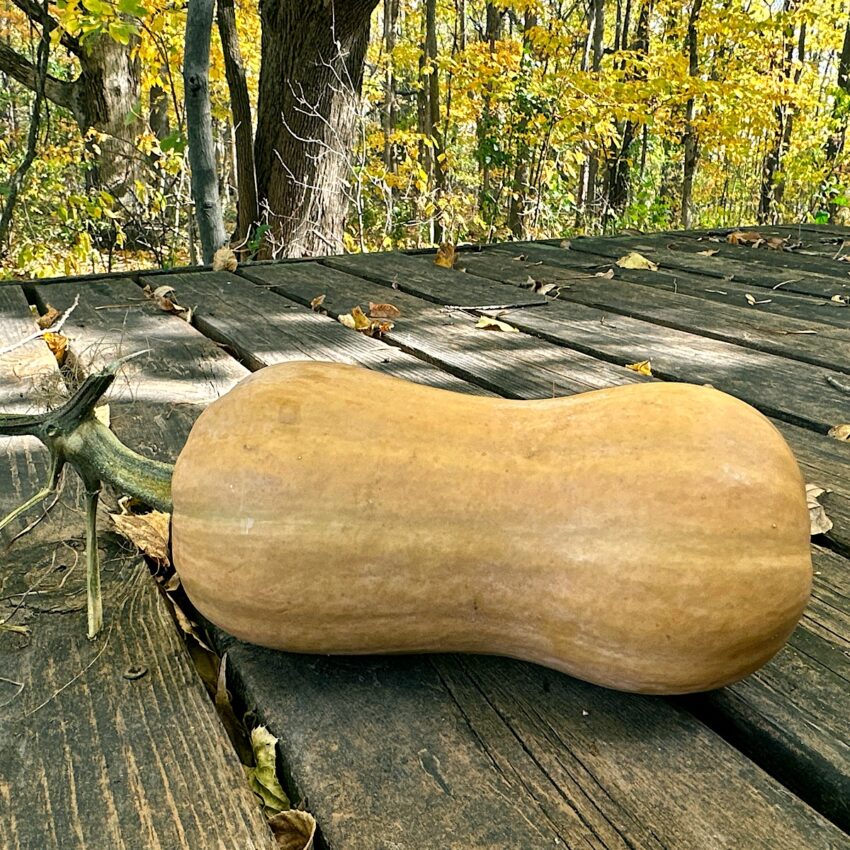
It’s not difficult to grow your own butternut squashes (or baby varieties like the smaller Butterbaby and Honeynut). Sow directly in the ground or indoors depending on your climate, making sure to go for a nice and sunny spot. Water plenty and you should be able to harvest your butternuts in around 110 days.
When it comes to cooking, butternut squashes are extremely versatile. They’re fantastic for roasting, but also go well with many other dishes. They are perfect for holiday cooking, as in this Mexican candied pumpkin recipe called Calabaza en Tacha.
6. Galeux D’Eysines
If you scrolled down to the photo below and went “what is THAT?!”, you’re not alone. The word “galeux” in the name of this heirloom squash actually refers to scabs or scabies, which its appearance really is a bit reminiscent of.
If the above sounds a bit too yucky, you can also call this one by its other common name: the peanut pumpkin.
Despite its funky appearance, this warty Cucurbita maxima is actually very sweet and tasty! It originates from France, specifically in Eysines, near Bordeaux. Apparently, it didn’t make its way to the US until 1996.

Galeux D’Eysines pumpkins mature in 90-100 days, which is quite quick. The vines like plenty of sun, warmth and space, while the warts or “peanuts” develop best when day and night temperatures vary significantly. The French like the fruit for soups, or try it roasted with some goat’s cheese.
7. Speckled Hound
Another Cucurbita maxima cultivar, the multicolored Speckled Hound winter squash is a real looker. The fruit can weigh up to 6 lbs and features a mottled pale orange and green pattern, especially along the ribs.
No two Speckled Hound pumpkins are the same.
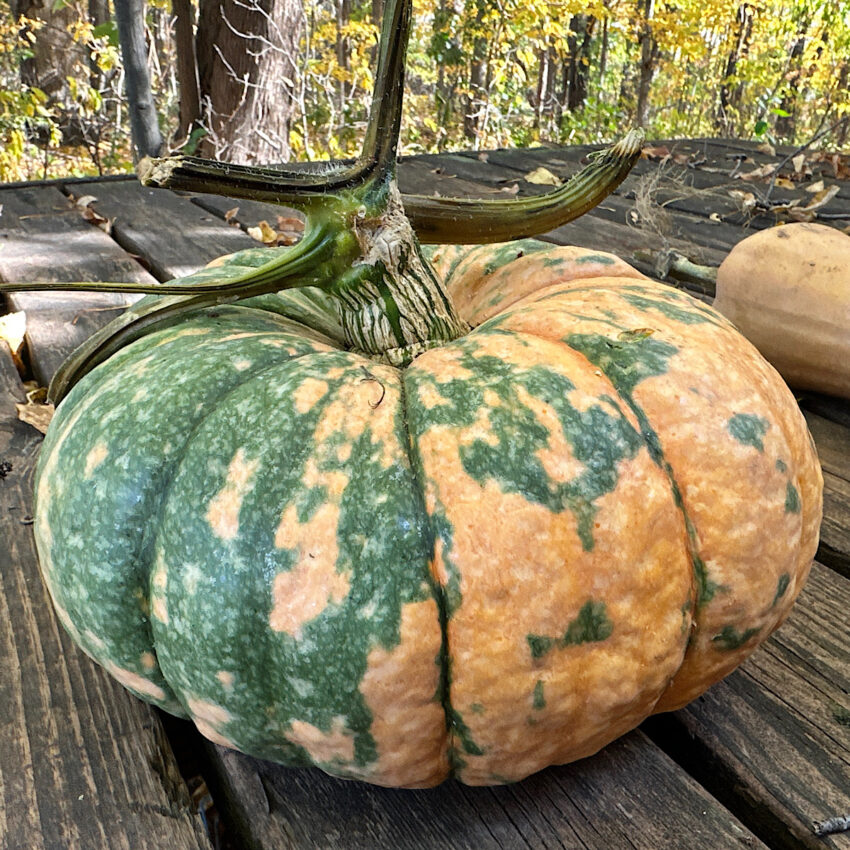
Speckled Hound winter squash is perfect for decoration, but don’t forget that it also tastes great. It has a fairly dry texture with a nutty, sweet flavor. This makes it a good option for roasting or incorporating into Fall-flavored baked goods like these pumpkin whoopie pies or this pumpkin amaretto quick bread.
Speckled Hound is easy enough to grow and relatively resistant to powdery mildew. It’s not a huge producer, but you’ll still get around 8 squashes per plant, which is more than respectable.
Maturation time is around 100 days.
8. Hull-less Heirloom Squash
If you’re a pumpkin seed freak, you’ll probably know that the seeds from pretty much any winter squash are edible. You’re likely also aware that peeling the white shells off them is quite the task – so much so that it isn’t always worth the yield.
Hull-less pumpkins and squashes (Cucurbita pepo), sometimes also referred to as pepita, oilseed or Styrian pumpkins offer the solution!
In this context, hull-less refers to the fact that the seeds of these squash varieties don’t have shells. This way, you get all the goodness and none of the work, with plenty of tasty squash flesh as an added bonus.
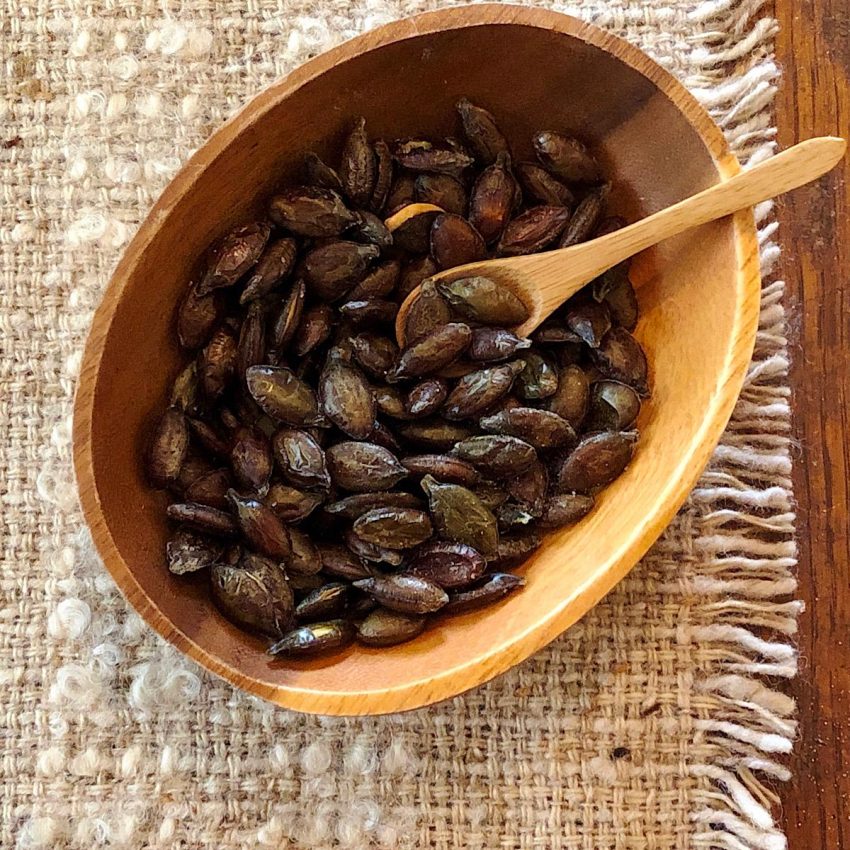
Squash or pumpkins with naked seeds likely first popped up around the 1880s in the Austrian region of Styria, where pumpkins had long been grown for their seed oil. Subsequently, several more cultivars were developed.
Some of the most popular hull-less squashes are:
- Styrian: Round Austrian native, yellow with mottled green, whose seeds are also commonly used to produce oil.
- Lady Godiva: Orange-yellow and green stripes, up to 8 pounds per fruit, with large and tasty seeds.
- Kakai: From Japan, this one is also striped, and produces delicious seeds.
- Retzer Gold: More mottled than striped, still perfectly round and quite nice to look at.
Once you’ve obtained your pumpkins, you can extract the seeds and remove any bits of flesh. Use the meat for something like these tasty pumpkin pancakes, and roast the seeds for a delicious snack or salad topping.
9. Moranga
Another beautiful winter squash with a classic “Cinderella” pumpkin appearance is the Brazilian Moranga, a Cucurbita maxima cultivar whose name is not to be confused with “morango” (which means “strawberry”).
The Moranga squash is appreciated worldwide for its pinkish orange color, deep ridges and great flavor.
Weighing in at up to 8 lbs, this heirloom squash is most well-known for its use in a dish called camarão na moranga, which basically means “shrimp in squash”. An appropriate name, given the fact that it basically consists of shrimp soup served in the Moranga pumpkin, and topped with extra shrimp!
Moranga pumpkin vines are nice and vigorous, maturing in around 95 days and producing plenty of fruit. Be sure to save a few of these squashes for your Fall decor, as they really are very nice to look at.
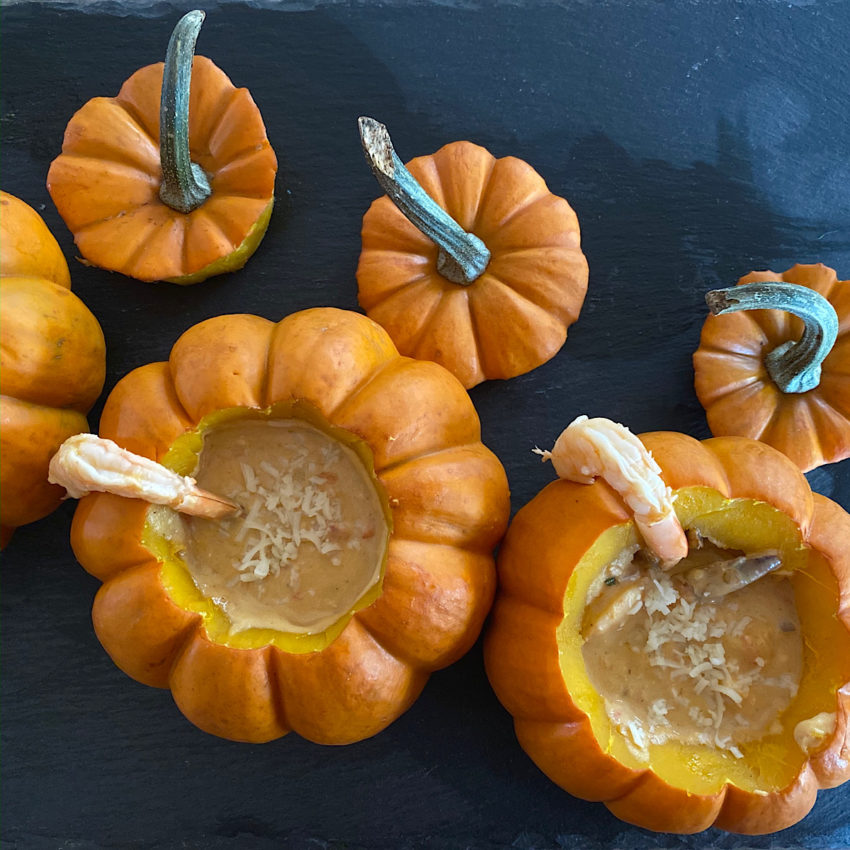
10. Red Kuri Squash (Hokkaido)
Perfectly round, thin-skinned and blindingly bright orange in color, the Japanese Red Kuri or Hokkaido winter squash is quite the looker. And that’s not all: it also tastes fantastic! Its nutty and sweet flavor makes it perfect for pretty much any recipe that calls for pumpkin, both savory and sweet.
First grown on the island of Hokkaido, the Red Kuri is likely the result of selective breeding with the Hubbard squash, which is discussed earlier in this post. It dates back to the 1920s, and can nowadays be found around the world.
As with many of the other winter squash varieties on this list, Red Kuris are not too challenging to grow. This variety is quite drought-tolerant, and although it prefers full sun, it will usually also manage to make do with a little less. It needs 90-95 days to mature.
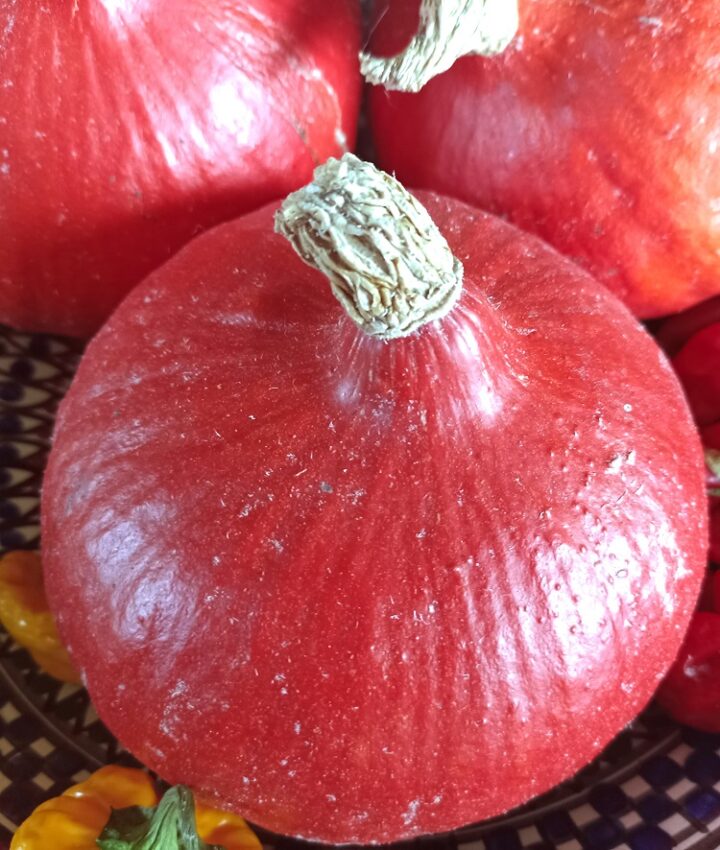
Pumpkins vs Winter Squash
You may have noticed that in this post, I refer to both “pumpkins” and “(winter) squashes”. But wait a second, aren’t pumpkins meant for decorating and winter squashes for eating? Actually, no.
Pumpkins are edible too, although many varieties aren’t commonly consumed because they’re simply not very nice. There are exceptions, though, including the ones mentioned here.
Basically, both pumpkins and winter squashes are members of the genus Cucurbita, the squashes. This genus also contains gourds, though those are really mostly decorative and almost never very tasty.
Botanically speaking, then, pumpkins and winter squashes are just varieties of the same plant. However, we gardeners like to refer to round subspecies and cultivars with hard and tough stems as pumpkins. These are often, but by no means always, Cucurbita pepo. Other shapes with thinner stems are called winter squash.
This confusion is a good example of why it’s often more helpful to use plants’ scientific names rather than their common ones.
Did you know? Botanically speaking, squashes like pumpkins are considered fruits, specifically berries, not vegetables.
Which pumpkins are edible?
When you find a bright orange pumpkin in the store, how do you know if you should be making pumpkin soup with it or turning it in a Jack-o-Lantern?
For starters, the decorative versions are often referred to as “carving pumpkins”. They’re very pretty, but their flesh tends to be relatively watery and stringy. Other than that, see if you can figure out the specific cultivar. If you’ve got that info, it’s easy to find out whether you’ve got food or decor on your hands.
The Cinderella, Hokkaido, Long Island Cheese, Galeux D’Eysines and Moranga pumpkins discussed here are all examples of tasty edible varieties.
Not-so-tasty pumpkins that are better for carving or giant pumpkin competitions include:
- Howden
- Jack-B-Quick
- Connecticut Field
- Atlantic Giant
- Big Max
- Gold Rush
- Jaune de Paris
- Ol’ Zeb’s
Frequently Asked Questions
There is no set definition of what a heirloom vegetable is exactly. However, with squashes, we can consider them heirlooms if they’re an old variety from before 1950. This especially applies if seeds were handed down as heirlooms within communities. They should be open-pollinated and breed true.
Absolutely. In fact, gardeners love growing heirloom squashes because they often taste much better than those you can buy in your local supermarket! This is because commercial varieties were bred to look pretty and ship well, not necessarily only for flavor.
If you like my articles about cooking and gardening, subscribe to my weekly newsletter, where I share free recipes and gardening tutorials.

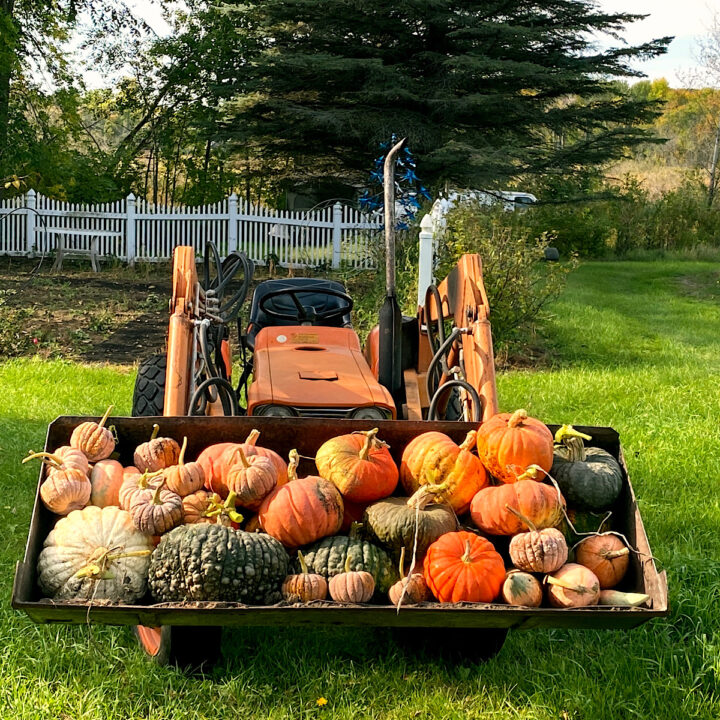
How do you prevent squash borer? This pest has become a problem when I grow any squash except butternut.
Thanks.
Keep a butterfly net in the yard Inspect your stems often and keep adding soil/compost over the first 7-12” of the stem. Kinda helps Otherwise you need to cut them out if you see the hole in the stem
I guess Buttercup squash is not an heirloom squash although it was developed at the University of N. Dakota for the northern plains. It’s really the only squash we have luck with in Bend. Fortunately it’s one of the best squash I’ve ever tasted. This year with “winter” temperatures and rain extending through late June, I didn’t even get the plants in until mid July although we are still having summer weather. (Soon to end, 80° Predicted Thursday, snow Saturday.)pThe red Kuri failed to make any fruits. But we still got several decent sized Buttercups and about 10 usable small ones.
Buttercup is indeed a great squash. I don’t know that the heirlooms are necessarily better tasting, I just like their uniqueness. The hull-less seed ones actually don’t taste good, but if you’re toasting a lot of seeds they’re great! In the end Mother Nature tells you which ones to grow in your area right?
you don’t mention pale grey Hopi squash a great old rare winter squash tht grows tin hot dry climates . but works fine here in western Oregon
Hi Jax, I’m so glad to hear you liked that one. We actually named our dog after it (his name is Hopi, lol). I didn’t include it because it wasn’t well received at market. I’ll grow it again next year based on your recommendation….it could have just been harvested at the wrong time. Thanks for the comment!